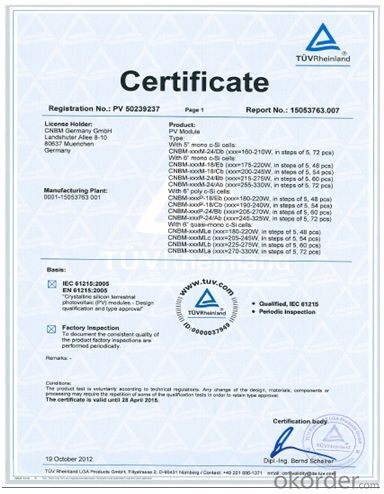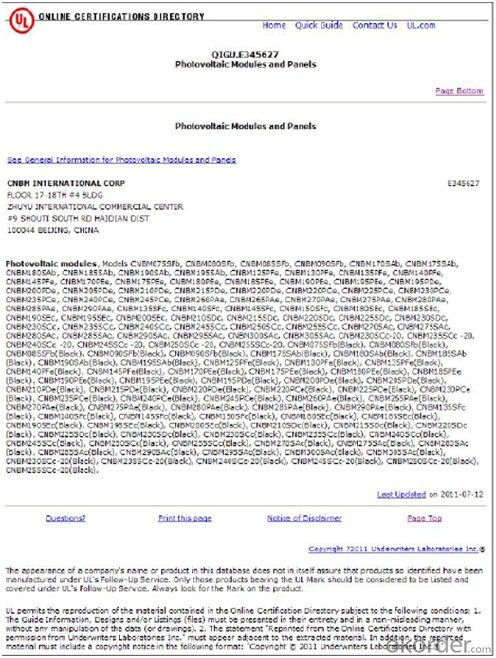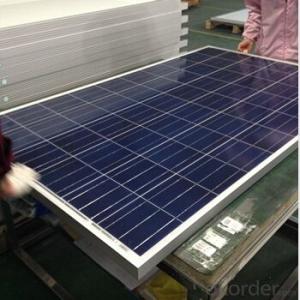Polycrystalline Solar Panels for 240W -156*156 Poly Cell
- Loading Port:
- Shanghai
- Payment Terms:
- TT OR LC
- Min Order Qty:
- 25 pc
- Supply Capability:
- 100000 pc/month
OKorder Service Pledge
OKorder Financial Service
You Might Also Like
Specifications:
Structure of Polycrystalline Solar Panel
Polycrystalline Solar Panel : High efficiency crystalline solar cell.
Even if under the weak light, the solar module can produce maximum power output.
II Tempered glass (toughened glass): Anti-reflecting coating and high transmission rate glass increase the power output and mechanical strength of solar module.
III EVA and TPT: Using high quality EVA and TPT to prevent destroying and water.
IV AI frame: Without screw, rner connection. 6 holes on the frame can be installed easily.
V Junction box: Multi function junction box with water proof.
VI Long lifetime: ≥25 years; Less power decrease.
VII Good performance of preventing from atrocious weather such as wind and hails.
VIII Resisting moisture and etching effectively, not effected by geology.
IX The certificate issued by international authority: UL, TUV, IEC, CE.
Standard Test Conditions of Polycrystalline Silicon Solar Panel:
The opto-electrical specifications shown below are stabilized values being measured at Standard Test Conditions, Irradiance: 1000W/m2, Spectrum: AM1.5 at 25°C, The info below is subject to manufacturing tolerances.
Where appropriate minutes of measurement are available and are used for the dimensioning of the installation.
Advantages of Monocrystalline Silicon Solar Panel
• CNBM Solar performance guarantees for 25 years
• 12 years guarantee for workmanship
• Timeliness of delivery
• Quality Products certified (TÜV, UL, CE, ISO)
Technical date :
ITEM NO.: | Poly 156*156 cell ,60pcs . Power range from 230Wp-260Wp | ||||||
Maximum Power(W) | 230 | 235 | 240 | 245 | 250 | 255 | 260 |
Optimum Power Voltage(Vmp) | 29.4 | 29.5 | 29.7 | 30.1 | 30.3 | 30.5 | 30.7 |
Optimum Operatige Current(Imp) | 7.83 | 7.97 | 8.08 | 8.14 | 8.25 | 8.37 | 8.48 |
Open Circuit Voltage(Voc) | 36.7 | 36.8 | 36.9 | 37.1 | 37.3 | 37.5 | 37.7 |
Short Circuit Current(Isc) | 8.52 | 8.59 | 8.62 | 8.65 | 8.69 | 8.73 | 8.78 |
Solar Cell: | 156*156 Poly | ||||||
Number of Cell(pcs) | 6*10 | ||||||
Name of Solar Cells | Polycrystalline Cell | ||||||
Size of Module(mm) | 1650*992*40/45/50 | ||||||
Cable & Connector Type | Pass the TUV Certificate | ||||||
Frame(Material Corners,etc.) | Aluminium-alloy | ||||||
Back sheet | TPT | ||||||
Weight Per Piece(KG) | 19.5KG | ||||||
FF (%) | 70-76% | ||||||
Junction Box Type | Pass the TUV Certificate | ||||||
Tolerance Wattage(e.g.+/-5%) | ±3%, or 0-3% | ||||||
Front Glass Thickness(mm) | 3.2 | ||||||
Temperature Coefficients of Isc(%) | +0.04 | ||||||
Temperature Coefficients of Voc(%) | -0.38 | ||||||
Temperature Coefficients of Pm(%) | -0.47 | ||||||
Temperature Coefficients of Im(%) | +0.04 | ||||||
Temperature Coefficients of Vm(%) | -0.38 | ||||||
Temperature Range | -40°C to +85°C | ||||||
Surface Maximum Load Capacity | 5400Pa | ||||||
Allowable Hail Load | 23m/s ,7.53g | ||||||
Bypass Diode Rating(A) | 12 | ||||||
Warranty | 90% of 10 years, 80% of 25 years. | ||||||
Standard Test Conditions | AM1.5 1000W/ 25 +/-2°C | ||||||
Packing | carton or pallet | ||||||
1*20' | 14 Pallets / 316pcs | ||||||
1*40'STD | 25 Pallets / 700pcs | ||||||




FAQ
We have organized several common questions for our clients,may help you sincerely:
①What price for each watt?
It depends on the quantity, delivery date and payment terms,
②What is your size for each module? Can you tell me the Parameter of your module?
We have different series of panels in different output, both c-Si and a-Si. Please take the specification sheet for your reference.
③Can you provide the peripheral products of the solar panels, such as the battery, controller, and inverter? If so, can you tell me how do they match each other?
Yes, we can, we have two companies for solar region, one is CNBM International, the other is CNBM engineering Co.
We can provide you not only the solar module but also the off grid solar system, we can also provide you service with on grid plant.
④What is your warranty system?
Our product performance guarantees for 25 years
• 12 years guarantee for workmanship
• Timeliness of delivery
• Quality Products certified (TÜV, UL, CE, ISO)
⑤How do you pack your products?
We have rich experience on how to pack the panels to make sure the safety on shipment when it arrives at the destination.
⑥ Can you do OEM for us?
Yes, we can.
- Q:Can solar cells be used for telecommunications infrastructure?
- Yes, solar cells can be used for telecommunications infrastructure. Solar cells convert sunlight into electricity, providing a renewable and sustainable source of power. By utilizing solar cells, telecommunication infrastructure such as cell towers, base stations, and remote communication devices can be powered independently, even in remote areas without access to the electrical grid. This helps to reduce reliance on fossil fuels, lower operational costs, and increase the reliability of telecommunications networks.
- Q:Can solar cells be used in harsh climates?
- Yes, solar cells can be used in harsh climates. While extreme temperatures, snow, and dust can potentially affect the efficiency and performance of solar cells, advancements in technology and design have made them more resilient. Specialized coatings, materials, and mounting systems are employed to protect solar cells from harsh weather conditions. In fact, solar panels are increasingly being used in various extreme climates around the world, including deserts and polar regions, proving their adaptability and effectiveness even in challenging environments.
- Q:Can solar cells be used on vehicles other than cars?
- Yes, solar cells can be used on vehicles other than cars. They can be installed on motorcycles, buses, trucks, boats, and even airplanes to generate electricity and reduce reliance on fossil fuels.
- Q:How do solar cells perform in areas with frequent hurricanes?
- Solar cells can still perform efficiently in areas with frequent hurricanes, provided they are properly installed and designed to withstand severe weather conditions. It is crucial to use durable materials and secure mounting systems to ensure the panels are not damaged or dislodged during high winds. Additionally, incorporating measures like reinforced frames and hurricane-resistant glass can further enhance their resilience. However, it is important to note that extreme weather events may temporarily disrupt solar power generation due to damaged infrastructure or reduced sunlight availability.
- Q:Can solar cells be used in street lighting?
- Yes, solar cells can be used in street lighting. Solar street lights combine solar panels, batteries, and LED lights to generate and store energy during the day, which is then used to power the lights at night. This renewable energy source makes solar cells an efficient and sustainable option for street lighting, reducing carbon emissions and reliance on the electrical grid.
- Q:What are the tin bands, sinks and interconnections used on solar modules, and what are the solar cells used in the solar cells?
- At present, the general crystal silicon cells using p-type silicon, in the phosphorus diffusion process, the two sides of the silicon and the edge will be phosphorus doping.
- Q:Can solar cells be used for aerospace applications?
- Yes, solar cells can be used for aerospace applications. They are commonly used in satellites and spacecraft to generate electrical power from sunlight. Solar cells are lightweight, reliable, and efficient, making them ideal for powering various systems and instruments in space missions.
- Q:Can solar cells be used in disaster recovery efforts?
- Yes, solar cells can be used in disaster recovery efforts. Solar cells can provide a reliable and sustainable source of electricity in areas affected by disasters, where traditional power grids may be damaged or inaccessible. They can be used to power emergency shelters, hospitals, communication systems, and other critical infrastructure, ensuring that essential services and relief efforts are not disrupted. Additionally, solar cells can be easily deployed and are not dependent on fuel supply, making them an ideal solution for disaster recovery efforts.
- Q:Can solar cells be used for powering traffic lights?
- Yes, solar cells can be used for powering traffic lights. Solar cells convert sunlight into electricity, which can be stored in batteries and used to power various devices, including traffic lights. This helps reduce dependence on the electrical grid and promotes renewable energy use.
- Q:Can solar cells be integrated into electric vehicle charging stations?
- Yes, solar cells can be integrated into electric vehicle charging stations. By harnessing solar energy, these charging stations can reduce reliance on the electrical grid and provide clean, renewable power for charging electric vehicles. This integration promotes sustainability and helps to reduce carbon emissions associated with transportation.
1. Manufacturer Overview |
|
|---|---|
| Location | |
| Year Established | |
| Annual Output Value | |
| Main Markets | |
| Company Certifications | |
2. Manufacturer Certificates |
|
|---|---|
| a) Certification Name | |
| Range | |
| Reference | |
| Validity Period | |
3. Manufacturer Capability |
|
|---|---|
| a)Trade Capacity | |
| Nearest Port | |
| Export Percentage | |
| No.of Employees in Trade Department | |
| Language Spoken: | |
| b)Factory Information | |
| Factory Size: | |
| No. of Production Lines | |
| Contract Manufacturing | |
| Product Price Range | |
Send your message to us
Polycrystalline Solar Panels for 240W -156*156 Poly Cell
- Loading Port:
- Shanghai
- Payment Terms:
- TT OR LC
- Min Order Qty:
- 25 pc
- Supply Capability:
- 100000 pc/month
OKorder Service Pledge
OKorder Financial Service
Similar products
New products
Hot products
Related keywords


























